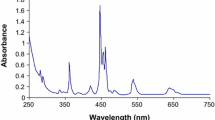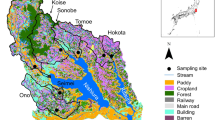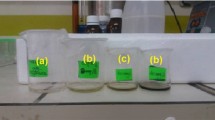Abstract
The direct spectrophotometric analysis of aqueous nitrates is a simple analytical procedure but prone to interferences. A twelve-month study of the Preakness Brook in Wayne Township, New Jersey demonstrated that two wavelength, three wavelength, and second derivative calculation methods provide very different results from the same ultraviolet absorption spectrum. On average, the two wavelength and second derivative methods yielded the same concentration at each sample point over the entire study period. These methods provided concentration results closest to those obtained by ion chromatography and significantly lower than the three wavelength computation method. The degree of variation between the different computation methods was not consistent as it rose with increasing absorbances at wavelengths associated with interfering compounds. This variation was especially pronounced between May and August.



Similar content being viewed by others
References
Bachmann, R., & Canfield, D. (1996). Use of an alternative method for monitoring total nitrogen concentrations in Florida lakes. Hydrobiologia, 323, 1–8.
Crumpton, W., Isenhart, T., & Mitchell, P. (1992). Nitrate and total nitrogen using second derivative spectroscopy. Limnology and Oceanography, 37, 907–913.
Ferree, M., & Shannon, R. (2001). Evaluation of a second derivative UV/visible spectroscopy technique for nitrate and total nitrogen analysis of wastewater samples. Water Research, 35, 327–332.
Finch, M., Hydes, D., Clayson, C., Weigl, B., Dakin, J., & Gwilliam, P. (1998). A low power ultra violet spectrophotometer for measurement of nitrate in seawater: Introduction, calibration and initial sea trials. Analytica Chimica Acta, 377, 167–177.
Hage, D., Chattopadhyay, A., Wolfe, C., Grundman, J., & Kelter, B. (1998). Determination of nitrate and nitrite in water by capillary electrophoresis: An undergraduate laboratory experiment. Journal of Chemical Education, 75, 1588.
Kalinichenko, I., & Demutskaya, N. (2004). Determination of nitrates in drinking water by three-wavelength ultraviolet photometry. Journal of Analytical Chemistry, 59, 211–214.
Minear, R. A. (1984). Water analysis, volume 2, inorganic species. Orlando, FL: Academic Press.
New Jersey Department of Environmental Protection, Trenton, New Jersey, DEP Dataminer, http://datamine.state.nj.us/dep/DEP_OPRA/index2.html.
Padarauskas, A., Paliulionyte, V., & Pranaityte, B. (2001). Single-run capillary electrophoretic determination of inorganic nitrogen species in rainwater. Analytical Chemistry, 73, 267.
Ponader, K., Charles, D., & Belton, T. (2007). Diatom-based TP and TN inference models and indices for monitoring nutrient enrichment of New Jersey streams. Ecological Indicators, 7, 79–93.
Standard Methods for the Examination of Water and Wastewater 18th Edition (1995). American Public Health Association, Washington, DC. pp. 4–120.
Standard Methods for the Examination of Water and Wastewater 21st Edition (2005). American Public Health Association, Washington, DC. pp. 4–85.
Wang, G. S., & Hsieh, S. T. (2001). Monitoring natural organic matter in water with a scanning spectrophotometer. Environment International, 26, 205–212.
Acknowledgements
The author wishes to thank the members of the Chemistry and Biochemistry Department at Montclair State, especially Dr. Pamela Delany and Dr. James Dyer who generously shared their laboratory space and supplies. The Montclair State University Earth and Environmental Sciences Department provided ion chromatography. Dr. Marc Kasner furnished invaluable assistance with the second derivative calculations. Caleb Faruki, Chris Newkirk, and Adam Weiss of the Weston Science Scholars program performed the aerial photograph interpretation.
Author information
Authors and Affiliations
Corresponding author
Rights and permissions
About this article
Cite this article
Olsen, K.K. Multiple Wavelength Ultraviolet Determinations of Nitrate Concentration, Method Comparisons from the Preakness Brook Monitoring Project, October 2005 to October 2006. Water Air Soil Pollut 187, 195–202 (2008). https://doi.org/10.1007/s11270-007-9508-8
Received:
Accepted:
Published:
Issue Date:
DOI: https://doi.org/10.1007/s11270-007-9508-8




